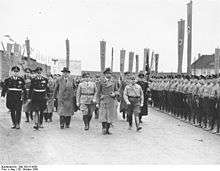Mittelland Canal
Coordinates: 52°25′16″N 9°42′4″E / 52.42111°N 9.70111°E

The Mittelland Canal, also known as the Midland Canal, (German: Mittellandkanal) is a major canal in central Germany. It forms an important link in the waterway network of that country, providing the principal east-west inland waterway connection. Its significance goes beyond Germany as it links France, Switzerland and the Benelux countries with Poland, the Czech Republic and the Baltic Sea.[1]
At 325.7 kilometres (202.4 mi) in length,[2] the Mittelland Canal is the longest artificial waterway in Germany.
Route
The Mittelland Canal branches off the Dortmund-Ems Canal[2] at Hörstel (near Rheine, at 52°16′37″N 7°36′18″E / 52.27694°N 7.60500°E), runs north along the Teutoburg Forest, past Hannover and meets with the Elbe River near Magdeburg (52°14′46″N 11°44′49″E / 52.24611°N 11.74694°E). Near Magdeburg it connects to the Elbe-Havel Canal,[2] making a continuous shipping route to Berlin and on to Poland.[1]
At Minden the canal crosses the river Weser over two aqueducts (the second completed in 1998), and near Magdeburg it crosses the Elbe, also with an aqueduct. Connections by side canals exist at Ibbenbüren, Osnabrück, Minden (two canals connecting to the Weser), Hanover-Linden, Hanover-Misburg, Hildesheim and Salzgitter.[2] West of Wolfsburg, the Elbe Lateral Canal branches off, providing a connection to Hamburg, and (via the Elbe-Lübeck Canal) to the Baltic Sea.
History

Construction of the Mittelland Canal was started in 1906, starting from Bergeshövede (municipality Hörstel) on the Dortmund-Ems Canal. The section to Minden on the Weser was opened in February 1915 and was initially named Ems-Weser-Kanal. The section from Minden to Hanover was finished in the autumn of 1916. The section to Sehnde and the branch canal to Hildesheim were completed in 1928, Peine was reached in 1929, and Braunschweig in 1933. The final section to Magdeburg was opened in 1938, thus creating a direct link between Western and Eastern Germany. The branch canal to Salzgitter was opened in 1941. The planned canal bridge over the Elbe, necessary to avoid low water conditions in summer, was not built due to the Second World War.[3]
After partitioning of Germany following the Second World War, the Mittelland Canal was split between West Germany and East Germany, with the border to the east of Wolfsburg. To provide access from the western section of the canal to Hamburg and Northern Germany, avoiding both East Germany and the Elbe River's sometimes limited navigability, the Elbe Lateral Canal was opened in 1977.
After the reunification of Germany, the importance of the Mittelland Canal as a link from the west to Berlin and the east was reinforced. The project to bridge the Elbe was therefore restarted, and the resulting Magdeburg Water Bridge opened in 2003, providing a direct link to the Elbe-Havel Canal. There are further plans to connect the channel to the Twentekanaal in the Netherlands to shorten the connection towards the Port of Rotterdam.[4]
Towns and cities
- Ibbenbüren
- Osnabrück (via a branch)
- Bramsche
- Lübbecke
- Minden
- Garbsen
- Hannover
- Sehnde
- Hildesheim (via a branch)
- Peine
- Salzgitter (via a branch)
- Braunschweig
- Wolfsburg
- Haldensleben
- Magdeburg

Structures
- Minden Aqueduct (52°18′12″N 8°55′54″E / 52.30333°N 8.93167°E)
- Magdeburg Water Bridge (52°13′51″N 11°42′5″E / 52.23083°N 11.70139°E)
Gallery
 Old and new Mittelland Canal aqueducts near Minden
Old and new Mittelland Canal aqueducts near Minden The Mittelland Canal near Minden
The Mittelland Canal near Minden Mittelland Canal / River Weser Lock at Minden, Germany taken in 1977
Mittelland Canal / River Weser Lock at Minden, Germany taken in 1977 Part of the original Volkswagen plant on the Mittelland Canal
Part of the original Volkswagen plant on the Mittelland Canal
References
- 1 2 Sheffield, Barry (1995). Inland Waterways of Germany. St Ives: Imray Laurie Norie & Wilson. ISBN 0-85288-283-1.
- 1 2 3 4 Elwis database WSD Mitte and WSD Ost
- ↑ Wasser- und Schifffahrtsamt Minden (German)
- ↑ Euregio: „Verbindung zwischen Mittellandkanal und Twentekanal nicht wirtschaftlich“. Stand: 2013. http://www.euregio.eu/de/pressemitteilungen/verbindung-zwischen-mittellandkanal-und-twentekanal-nicht-wirtschaftlich (abgerufen am 02. Oktober 2014).
| Wikimedia Commons has media related to Mittellandkanal. |